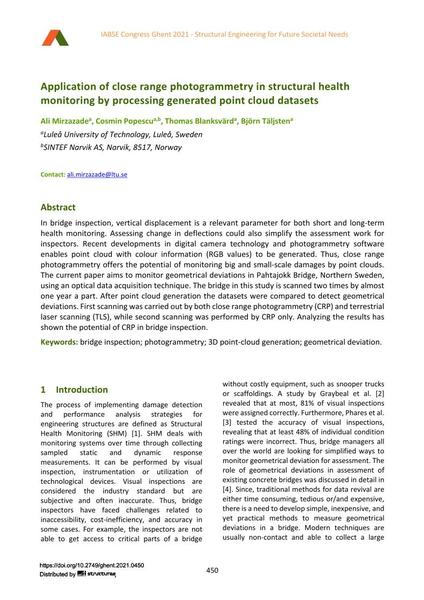Application of close range photogrammetry in structural health monitoring by processing generated point cloud datasets

|
|
|||||||||||
Détails bibliographiques
| Auteur(s): |
Ali Mirzazade
(Luleå University of Technology, Luleå, Sweden)
Cosmin Popescu Thomas Blanksvärd (Luleå University of Technology, Luleå, Sweden) Björn Täljsten (Luleå University of Technology, Luleå, Sweden) |
||||
|---|---|---|---|---|---|
| Médium: | papier de conférence | ||||
| Langue(s): | anglais | ||||
| Conférence: | IABSE Congress: Structural Engineering for Future Societal Needs, Ghent, Belgium, 22-24 September 2021 | ||||
| Publié dans: | IABSE Congress Ghent 2021 | ||||
|
|||||
| Page(s): | 450-458 | ||||
| Nombre total de pages (du PDF): | 9 | ||||
| DOI: | 10.2749/ghent.2021.0450 | ||||
| Abstrait: |
In bridge inspection, vertical displacement is a relevant parameter for both short and long-term health monitoring. Assessing change in deflections could also simplify the assessment work for inspectors. Recent developments in digital camera technology and photogrammetry software enables point cloud with colour information (RGB values) to be generated. Thus, close range photogrammetry offers the potential of monitoring big and small-scale damages by point clouds. The current paper aims to monitor geometrical deviations in Pahtajokk Bridge, Northern Sweden, using an optical data acquisition technique. The bridge in this study is scanned two times by almost one year a part. After point cloud generation the datasets were compared to detect geometrical deviations. First scanning was carried out by both close range photogrammetry (CRP) and terrestrial laser scanning (TLS), while second scanning was performed by CRP only. Analyzing the results has shown the potential of CRP in bridge inspection. |
||||
| Copyright: | © 2021 International Association for Bridge and Structural Engineering (IABSE) | ||||
| License: | Cette oeuvre ne peut être utilisée sans la permission de l'auteur ou détenteur des droits. |
||||
